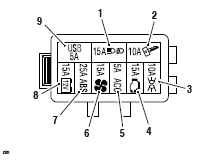 Triumph Street Scrambler - Owner's Manual > Battery Discharge
Triumph Street Scrambler - Owner's Manual > Battery Discharge
Caution
The charge level in the battery must be maintained to maximise battery life.
Failure to maintain the battery charge level could cause serious internal damage to the battery.
Under normal conditions, the motorcycle charging system will keep the battery fully charged. However, if the motorcycle is unused, the battery will gradually discharge due to a normal process called self discharge; the clock, Engine Control Module (ECM) memory, high ambient temperatures, or the addition of electrical security systems or other electrical accessories will all increase this rate of battery discharge.
Disconnecting the battery from the motorcycle during storage will reduce the rate of discharge.
Battery Discharge During Storage and Infrequent Use of the Motorcycle
During storage or infrequent use of the motorcycle, inspect the battery voltage weekly using a digital multimeter. Follow the manufacturer's instructions supplied with the meter.
Should the battery voltage fall below 12.7 Volts, the battery should be charged.
Allowing a battery to discharge or leaving it discharged for even a short period of time causes sulphation of the lead plates. Sulphation is a normal part of the chemical reaction inside the battery, however over time the sulphate can crystallise on the plates making recovery difficult or impossible. This permanent damage is not covered by the motorcycle warranty, as it is not due to a manufacturing defect.
Keeping the battery fully charged reduces the likelihood of it freezing in cold conditions. Allowing a battery to freeze will cause serious internal damage to the battery.
Battery Charging
Warning
The battery gives off explosive gases; keep sparks, flames and cigarettes away. Provide adequate ventilation when charging or using the battery in an enclosed space.
The battery contains sulphuric acid (battery acid). Contact with skin or eyes may cause severe burns. Wear protective clothing and a face shield. If battery acid gets on your skin, flush with water immediately. If battery acid gets in your eyes, flush with water for at least 15 minutes and SEEK MEDICAL ATTENTION IMMEDIATELY. If battery acid is swallowed, drink large quantities of water and SEEK MEDICAL ATTENTION IMMEDIATELY.
KEEP BATTERY ACID OUT OF THE REACH OF CHILDREN.
Caution
Do not use an automotive quick charger as it may overcharge and damage the battery.
For help with selecting a battery charger, checking the battery voltage or battery charging, contact your local authorised Triumph dealer.
Should the battery voltage fall below 12.7 Volts, the battery should be charged using a Triumph approved battery charger. Always remove the battery from the motorcycle and follow the instructions supplied with the battery charger.
For extended periods of storage (beyond two weeks) the battery should be removed from the motorcycle and kept charged using a Triumph approved maintenance charger.
Similarly, should the battery charge fall to a level where it will not start the motorcycle, remove the battery from the motorcycle before charging.
Battery Installation
Warning
Make sure that the battery terminals do not touch the motorcycle frame as this may cause a short circuit or spark, which would ignite battery gases causing a risk of personal injury.
Street Twin, Street Cup, Street Scrambler, Bonneville T100 and Bonneville T120
Place the battery in the battery case.
Refit the USB port socket and secure with the battery strap.
Reconnect the battery, positive lead (identified with red tape) first.
Tighten the battery terminals to 4.5 Nm.
Apply a light coat of grease to the terminals to prevent corrosion.
Cover the positive terminal with the protective cap.
Place the ECM unit in its original position.
Reconnect the rear light and accessory cables.
Refit the fixing to secure the ECM unit.
Refit the seat
Thruxton and Thruxton R
Place the battery in the battery case.
Secure with the battery strap and make sure the USB port socket is refitted.
Reconnect the battery, positive lead (identified with red tape) first.
Tighten the battery terminals to 4.5 Nm.
Apply a light coat of grease to the terminals to prevent corrosion.
Cover the positive terminal with the protective cap.
Refit the seat
Fuse Box
Warning
Always replace blown fuses with new ones of the correct rating (as specified on the fuse box cover) and never use a fuse of higher rating.
Use of an incorrect fuse could lead to an electrical problem, resulting in motorcycle damage, loss of motorcycle control and an accident.
Note:
A blown fuse is indicated when all of the systems protected by that fuse become inoperative. When checking for a blown fuse, use the table to establish which fuse has blown.
The fuse box is located underneath the seat.
To allow access to the fuse box, the seat must be removed

Fuse Box

See also:
 Triumph Street Scrambler - Owner's Manual > Battery Removal
Triumph Street Scrambler - Owner's Manual > Battery Removal
Street Twin, Street Cup, Street Scrambler, Bonneville T100 and Bonneville T120 Battery Negative (-) terminal Battery strap Positive (+) terminal Fixing Rear light cable Accessory cable Engine Control Module (ECM) unit
 Triumph Street Scrambler - Owner's Manual > Headlights
Triumph Street Scrambler - Owner's Manual > Headlights
Warning Adjust road speed to suit the visibility and weather conditions in which the motorcycle is being operated.
 Ducati Scrambler
Ducati Scrambler Fantic Caballero 500
Fantic Caballero 500 Indian FTR 1200
Indian FTR 1200 Moto Guzzi V85 TT
Moto Guzzi V85 TT Royal Enfield Bullet Trials Works Replica
Royal Enfield Bullet Trials Works Replica Triumph Scrambler 1200 XE
Triumph Scrambler 1200 XE Triumph Street Scrambler
Triumph Street Scrambler Yamaha XSR700
Yamaha XSR700 Ducati Scrambler 800
Ducati Scrambler 800 Moto Guzzi V85 TT
Moto Guzzi V85 TT Triumph Scrambler 1200 XC
Triumph Scrambler 1200 XC